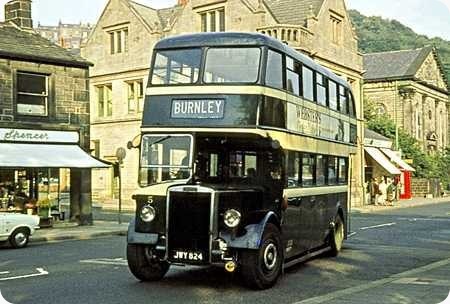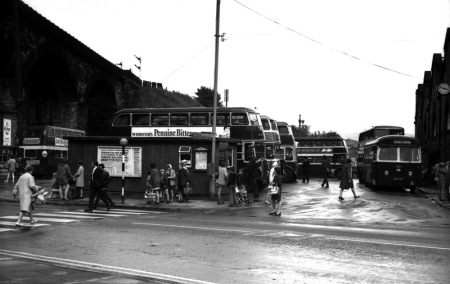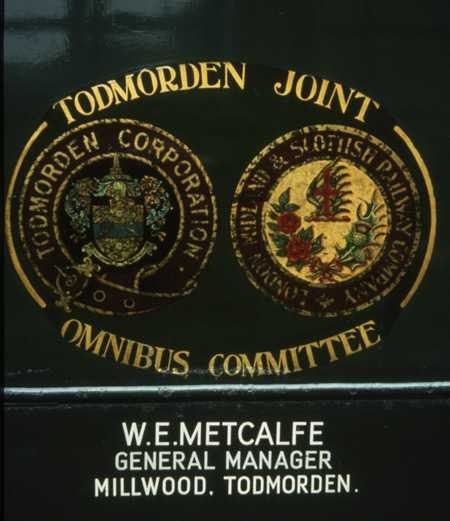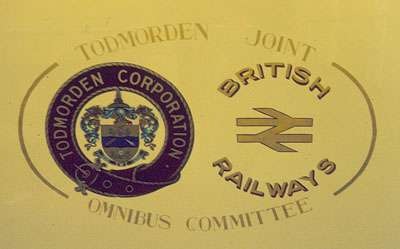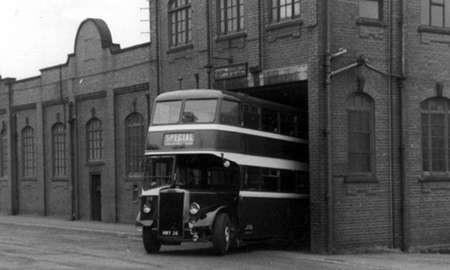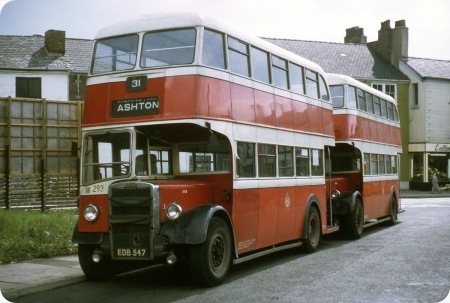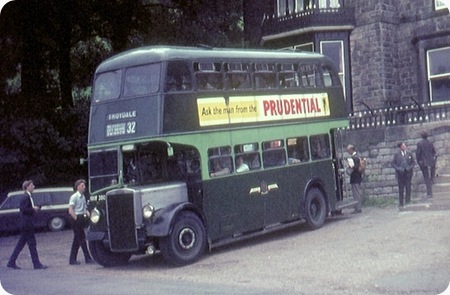Todmorden Corporation – Leyland Titan PD2 – JWY 824 – 5
Todmorden Corporation and Joint Transport Committee
1950
Leyland Titan PD2/1
Leyland L27/26R
Scanning through the OBP Operators Index I just noticed a glaring omission. What – No Todmorden?
How could this possibly be ?
So here to immediately rectify the situation is their 1950 Leyland-bodied PD2/1 No. 5 departing Hebden Bridge for Burnley via Todmorden, in the Summer of 1969.
It has just left its dismal terminus in Cheetham Street – behind the Hope Chapel in the background – where it will have connected with the inbound Halifax J.O.C. route 48/49 from Brighouse. It has then turned left into Crown Street, and it is here seen completing its next turn right into New Road, ready for a spirited run along the Calder Valley to ‘Tod’, then on through Cornholme, Portsmouth and the Cliviger Gorge and into the County of the Red Rose.
Todmorden Joint Omnibus Committee was a staunch devotee of the Leyland marque, and for a period their fleet consisted solely of 38 PD2’s dating from between 1947 and 1951 – surely a fleet engineer’s dream?
This one passed to the Calderdale J.O.C. in 1971 becoming their 352, but it was withdrawn shortly afterwards and passed to Mulley’s of Ixworth. They withdrew it in 1977 and sold it to Bickers of Coddenham – acting as dealers – from whom it passed to the Stella Artois brewery in Belgium (who I trust paid a Reassuringly Expensive price for it).
Similar 1948 bus no. 2 survives in preservation, but does anyone know if No. 5 survived?
Photograph and Copy contributed by John Stringer
19/04/12 – 06:31
Beautiful picture of a beautiful bus in beautiful condition. 19 years old? What are the chances of a Dennis or Volvo lasting that long, let alone in that condition?
David Oldfield
19/04/12 – 06:31
Superb photograph of a classic municipal bus. ‘Tod’ buses did a fair bit of moorland hill climbing as well as serving the valley bottom roads by the River Calder. They ran on the Burnley to Bacup route which climbed to a fair height at Weir, they then usually continued from Bacup back to ‘Tod’ over another mooorland summit by Temperley’s brickworks at Sharneyford. If that wasn’t enough for the venerable PD2’s they went over to Keighley via a bleak moorland run over Cock Hill. In later years Leopard saloons replaced the PD2’s and some of the routes were given up as being uneconomical.
Philip Halstead
19/04/12 – 06:32
Can I say what a super pic: in the usual Todmorden sunshine. Makes you wonder why anyone ran anything else, especially with the longevity of these bodies- and look how smart on 20 years. Is it true- have I read it here- that the low bridge in Todmorden was the depot entrance?
Joe
19/04/12 – 07:27
Joe, you’re right about the low bridge. Originally there was a bridge on the Burnley Road but that was rebuilt in the 1930s and it was the depot that remained the restriction.
I liked Todmorden a lot and spent quite some time there riding and photographing in 1971 when it was Calderdale-owned but still of Todmorden character, with seven PD2s active. Given that the newest was twenty years old to say it was a surprise when two of them were repainted in Calderdale livery is something of an understatement.
However, when you say the bus connected at Hebden Bridge with the Halifax 48/49 you highlight one of the problems with the Todmorden network which turned back at the "boundaries". At both Hebden Bridge and Littleborough Summit, where Todmorden’s buses met those of Rochdale (later SELNEC), the twenty-minute frequency Todmorden service met a fifteen-minute frequency services, so good connections were not always assured.
Todmorden had some good destinations, from the confusing Portsmouth to Mankinholes and Lumbutts, the latter being very scenic services. They were so keen on Leylands they even ran them to the Cross Lee estate!
The attached photograph shows six of the seven PD2s in the centre of Todmorden on 4th August 1971, a very fortunate combination. To think that the reason I was there was to publicise a vintage vehicle rally, namely the third Trans-Pennine Run! I’d rather just get on a service bus!
David Beilby
19/04/12 – 10:25
Oh, if only present day operators would realise that dignified liveries of this kind, whether tastefully restrained like Todmorden or rather brighter but equally "rich" like many others, do more to reinforce the owners’ stability and pride than all the expensive and totally meaningless "fairground or nursery school" offerings we have to endure today – one could hardly imagine the PD2s disguised as furniture vans and with virtually every window covered with a certain "stuff" which purports to allow perfect vision from within !!
As regards the incredible longevity of the Leyland bodies I have happy personal experience of working on many such fine vehicles. When I was with Samuel Ledgard we had a dozen such vehicles from new and a greater number second hand, most of which had simply "nipped over the Pennines" to join us in their later years. We had four highbridge PD1s from Ribble and seven from Preston Corporation, all around fifteen years old when acquired and in incredibly superb order and requiring virtually no attention. A further four lowbridge PD2s from Ribble followed, along with one from West Wales. Other bargains of the same reliable chassis included three PD1s with ECW bodies (a fascinating and pleasing combination to me) and three with BBW bodies – those six all from Bristol. Then there was a lone PD2/MCW from Tynemouth, and there were two more Ribble PD1s from the same batch as those first mentioned above – but these had been upgraded to PD2 form and rebodied by Burlingham.
It may be thought that such vehicles, purchased by a private operator while well in their dotage, would enjoy a quiet easy time but not a bit of it. The Ledgard services were intense, heavily patronised, often hilly, and tightly timed. nevertheless the fine Leyland vehicles performed like heroes under all conditions – a tribute indeed to the maintenance standards of their original owners and to the excellent attention practised by Samuel Ledgard.
An illustration of the intensity of the services can be given in the 5.30pm weekday departure from Leeds (King Street) to Ilkley via Guiseley, which required no less than four double deckers – two "part journey" buses left at 5.27 and 5.28 while the two Ilkley machines left at 5.29 and 5.30. Very occasionally the short distance riders could find themselves luxuriantly carried home in a nice coach if a vehicle shortage dictated this.
Perhaps the very finest of the second hand arrivals (no disrespect to the other splendid purchases) were the four Ribble PD1s 2471/2/8/9 BCK 414/415/421/422.
These retained above the windscreens in the cabs (undoubtedly a bit of lovely mischief by our Ledgard painters) a notice warning "BOOTLE DEPOT – NOT TO BE DRIVEN UNDER ***** BRIDGE."
Well, I must apologise to the historians of the splendid Todmorden undertaking for "drifting off", but these recollections do, to be fair, reflect some of the wonderful story and magic of Leyland and Lancashire "real" bus operation.
Chris Youhill
19/04/12 – 13:55
A very interesting and colourful post, Chris Y – drift off course as much as you like.
Chris Hebbron
19/04/12 – 16:15
Todmorden – a delightful Leyland print. How many people remember these somewhat unique coloured buses at the Yeadon Air Displays in the 1950s on hire to West Yorkshire Road Car alongside the Ledgard, West Riding, Leeds and Bradford Corporation hired in buses of the day at this annual event.
David Allen
19/04/12 – 16:17
With todays buses its a hard job to make them look smart, these are the exact opposite and it would be a hard job to make them look bad, no matter how hard some ‘Corporate image consultants’ may try.
Ronnie Hoye
19/04/12 – 17:51
I think Mulleys bought a total of four of these PD2s, I used to see one of them on a daily basis still in original livery working out of Mulleys ex Corona depot at Acton (near Sudbury, not London). It was said that Mulleys came to acquire them because the very enthusiastic Jack Mulley was fond of personally driving excursion coaches to Great Yarmouth in the 1960s when G. G Hilditch (later at Halifax/Todmorden) was General Manager at Great Yarmouth Corporation and so they came to know each other.
Nigel Turner
20/04/12 – 07:18
I feel the hand of Geoffrey Hilditch must have been behind the painting of the two PD2’s in Calderdale (Halifax) livery. Being an enthusiast as well as the manger must have been too much of a temptation to resist. In fairness though the two were of the newer PD2/12 batch and I used to see them on service around Todmorden when I lived there in the mid-1970’s. Needless to say they looked superb.
Just to point out to Chris regarding his reference to Lancashire, Todmorden is in Yorkshire despite having a Lancashire postal address and in BR days the station was in the London Midland Region with maroon signs. It’s a bit of a mixed up sort of place with its geography.
Philip Halstead
20/04/12 – 07:19
I imagine that every contributor to these pages, myself included, would give almost anything to be able to ride on and even more to drive such a superb bus as the Todmorden PD2 or any vehicles of that era.
The obvious care given to both the appearance of body work after such long and hard service and the equal care that must have been given to the mechanical side are of huge credit to it’s late lamented owners.
Care such as that will never be given to todays guady, over-decorated and uncomfortable offerings to which no real thought seems to have been given, perhaps that will mean they won’t last as long and who would want or be able to preserve one of those electronic "marvels".
Diesel Dave
20/04/12 – 07:20
It has always amused me that Todmorden Bus Station was always referred to as The Bus Departure Place. If the city fathers had not been economical with the stone work at the depot then there would have been no need for low bridge deckers.
Philip Carlton
20/04/12 – 07:21
Todmorden seems to have purchased a large number of all-Leyland double deckers over the years and one thing that surprises me is that some had very long lives with them and yet some were sold after twelve or thirteen years. Barton Transport bought two TD5’s from them in 1951 and got a further ten years service out of them. Later, in 1962, Barton’s purchased three PD2/1’s and again got long service from them. I think they knew that ex-Todmorden vehicles were very good purchases!
David’s comment about the PD2’s being re-painted when Calderdale took over the fleet made me smile. I think that as good as they undoubtedly were, any other engineer would have retired them on acquisition but good old Mr Hilditch couldn’t resist the temptation to have them in his fleet!
Chris Barker
20/04/12 – 13:45
Wasn’t Todmordens town hall half in Lancashire and half in Yorkshire?
Roger Broughton
20/04/12 – 13:44
Philip Halstead’s comment on the ambiguous county status of Todmorden reminds me of the fact that, until 1888, the boundary ran right through the town. Between 1875 and 1888, dancers in the Town Hall ballroom were able to waltz across the boundary on each circuit! I used to do business with a cotton mill in Walsden (2 miles south-east) and they were definitely Lancastrian in accent, attitude and cricket persuasion! Indeed, the current Yorkshire-based Walsden and Todmorden cricket teams all still play for the Lancashire League.
Reverting to a transport theme, had it not been for a delay in implementing the 1902 Todmorden Corporation Tramways Order, and the early introduction of pioneer motor buses in 1907, I doubt that we would now be discussing an all-lowbridge fleet. Todmorden was always a "missing link" in the Lancashire/Yorkshire tram network. Had their system been built, through-services may have been possible to Rochdale via Summit (assuming Todmorden adopted Rochdale’s standard gauge) but this would have precluded through running to Halifax via Hebden Bridge, as theirs was a 4ft system. Interestingly, in 1920, Halifax was actually authorised to extend their Hebden Bridge tram service to the Todmorden boundary but, of course, it was never built.
Paul Haywood
20/04/12 – 16:26
The original depot is still in existence and still in use by First. The ability of Daimler to provide a genuine low height Fleetline was one of the factors which meant they became the standard rear engined Halifax bus as they could enter the Millwood depot.
Chris Hough
20/04/12 – 16:27
It has often been said that Todmorden’s livery was dark and sombre – especially by those from ‘up the valley’ more used to Halifax’s colourful scheme. Although when newly painted the green shade appeared a kind of rich, dark olive, a combination of period paint technology and industrial pollution quickly turned the green very dark – almost black with a hint of green. Despite this – maybe even because of it – I personally thought they looked classy and dignified.
TJOC buses always gave the impression of being extremely well maintained, both mechanically and bodily, and were always spotlessly clean inside. Though in its last years it was struggling to make ends meet financially, these standards of presentation never dropped, and the tradition continued under Calderdale JOC, and right into the WYPTE and Yorkshire Rider periods. Even in those times Tod’s workshops were very well equipped and their staff very capable of carrying out quite major work – including serious accident repairs – and Halifax would sometimes send their buses ‘down the valley’ to get them sorted.
Sometimes Tod’ buses would be sent up to Halifax’s Elmwood workshops for servicing and repairs, and having been released for service by mid-afternoon would be used there for the rest of the day before been returned to their proper home. Halifax drivers appreciated this and would frequently comment how much better they ‘motored’ and above all how well their heaters and demisters always worked compared to their own.
John Stringer
21/04/12 – 08:30
Some excellent comments – I live in Walsden and we still have a good bus service, the Millwood depot is still in use and the route over the top from Hebden Bridge to Keighley is one of England’s most scenic.
Yes the Town Hall was half in Lancashire and half in Yorkshire until 1889, when, under the 1888 Local Government Act I think, the boundary was moved westwards. We still have the OL (Oldham) postcode and 01706 (Rochdale) phone numbers. I think Portsmouth remained in Lancashire for a bit longer.
Geoff Kerr
21/04/12 – 08:31
With reference to Philip Carlton’s comment I have never heard the term "Bus Departure Place" used officially. The official name was "Bus Starting Centre" (or so I always understood) although I believe it’s now officially Todmorden Bus Station. How sad: why make it the same as everywhere else in stead of retaining something unique?
Regardless of that, though, what a fabulous photo as many have already said, capturing not only the beautiful Leyland but also the essence of Hebden Bridge with the lovely, solid, stone buildings in the foreground and the precariously built terrace atop the hill behind.
Can I also "cast a vote" in favour of the low depot roof? I’ve always had a soft spot for sunken gangways (not that they’re ideal for people of my height!) and for the proportions of most lowbridge buses.
By the way, is Hebden Bridge Railway Station still maintained in a traditional style? It must be at least 10 years since I was last in it but it was beautifully preserved like a station on the K&WVR or similar.
Alan Hall
21/04/12 – 08:32
Many thanks to Philip for highlighting the fascinating and long standing saga of Todmorden’s eternal dilemma of allegiance. I actually worded my final comment somewhat misleadingly, and my reference to "Leyland and Lancashire real bus operation" was simply a commendation of the splendid standards of Preston Corporation and of Ribble.
Chris Youhill
22/04/12 – 07:31
In the mid sixties, I was working in Melling and travelled daily on Ribble route 301 from Liverpool, usually on a PD3, either the early Burlingham or the later MCW ones. All these buses seemed to be governed the top speed between 25 and 30 mph.
If a bus was running late for any reason it ran late for the whole journey as the driver was unable to make up the lost time.
Jim Hepburn
21/05/12 – 08:10
Thanks guys for your very interesting and colourful comments about Todmorden J.O.C.s buses, the 2nd Municipal Corporation to run motor buses. The first picture is particularly interesting to myself since I passed my PSV test on Number 5 the previous year and, (who knows) it could even be me driving it? Todmorden was operated like a happy ‘Family’ concern under a gentleman of a manager, William Edward Metcalfe, (or ‘Teddy’). The livery was Brunswick Green & Cream and when buses required painting they were done so by Jim Hoyle who travelled from Bacup over Sharnyford to get to his work on a motor bike. Despite some terrible winters, especially over Deerplay Moor, Sharneyford or Oxenhope Moor, I don’t recall our services ever being stopped, Snow, Fog or Ice were no obstacle for us due to a terrific team of Todmorden Council workers who kept the roads open for us, whereas Rochdale could stop if the wind changed direction and Halifax were often not much better. The reason for low bridge type deckers was the height of the original eastern end of Millwood Depot but the following three extensions were built higher. Also, as is said, the Hungrtwood Arch at Portsmouth required a delicate approach at an angle, when the early upper saloon passengers were warned not to stand up. The replacement iron railway bridge removed that problem.
The boundary always causes arguments but yes, Todmorden is in Yorkshire, for administrative purposes but the physical boundary cannot be removed, ie; the river ‘Walsden Water’ runs under and from one corner of the town hall to exit at the opposite corner of the round end and as has already been pointed out, ballroom dancers continually and unknowingly changed from Yorkshire into Lancashire and back again. That actually placed the Depot in Yorkshire with the Bus Station in Lancashire. To many residents the town is still half and half and the discussion will continue but to many of us it will always be Red Rose Lancashire. Sorry about the last bit but it keeps everyone interested.
Ken Lobley
22/05/12 – 07:40
A little late in the day, but I’ve just come across this postcard of a scene taken in Hebden Bridge. It shows (left) one of Todmorden’s 1928 piano-fronted TD1’s, (centre) a Halifax tram returning on the 8-mile route back to the city, and (right) a Halifax AEC Regal (JX 1955) about to set off for Heptonstall (presumably before the extension into the notoriously narrow village?). This photo is also shown in the excellent "Halifax Corporation Tramways" (Thornton/King) publication and has a date of 1932. However, my postcard gives a precise date of 9th August 1931 and is credited to a Mr S.L. Smith. The Todmorden bus is, of course, just about to make the same turn out of Cheetham Street as our PD2 posting above. Note the pre-steam cleaned bank building on the older view. Remarkably, most of these buildings are still extant, apart from the mill bridge in the far distance.
Paul Haywood
06/07/12 – 14:37
What a cracking posting with some superb period ‘atmos pics’ as they were once called.
Roger Broughton
14/09/12 – 06:47
Being a Tod lad I spent many happy hours riding on the ‘PD2s’ my favourite being number 2. Does anyone know who restored her and where she is now or did any of the other PD2s survive because if so, I would be very interested in acquiring one!
Paul Stothart
18/09/12 – 07:31
I sincerely hope that they sandblasted the bank building – had they steam cleaned it, it might not now be standing..
Incidentally, could someone perhaps confirm why there were apparently two power wires for the tramway – was it to avoid a frog at the diverging points which I presume were located not far up the road? Would the conductor have had to manually move the trolleypole to the opposite wire?
David Call
5 minutes later
Ignore the above dopey comment – as it was a terminus, the conductor would have had to move the trolleypole anyway!
David Call
19/09/12 – 07:06
…but why are there two tram wires for one track? Don’t tell me- the electricity went the other way! This is presumably just before the river bridge, and the single tram track just stops: did the tram always do so too?
Joe
10/10/12 – 09:14
In reply to Paul Stothart. (14.09.12), Todmorden PD2/1 Fleet number 2 was a terrible bus to drive when it was in service because it had a very poor lock in one direction. It was preserved simply because it was bus No2 which did the inaugural run in 1907 due to No1 having frozen to the ground. No2 was in the care of Todmorden Antiquarian Society for some years but unable to finance the upkeep, it went into the care of David Powell who had a wonderful restoration done on it, correcting the poor steering lock in the process. The bus was resident down south the last I heard of it. Another PD2/1 was partly restored on a farm in south midlands some years ago but I lost track of it. A TJOC PD2/12 was destined for restoration after Halifax decommissioned it but I think that one has been scrapped? Leopard/Willowbrook No9 is still doing the rallies in West Yorkshire with John Flowers at the helm and No15, (ex=Tow Bus) is currently under restoration to its original single deck bus form by Mike Sutcliffe, ‘The Leyland Man’, who also owns the famous open top Leyland G2 No14. One of the Leopard/Seddon-Pennine buses from TJOC was offered to me when Blue Bus sold it but I lost track of that one also. The one’s that did have a possible future in restoration were usually purchased from Mulley’s but I guess they have all long gone now?
Ken Lobley (ex-TJOC)
05/12/12 – 17:59
Hi there, I have enjoyed reading the messages on your page & seeing a dear old Tod bus. Happy days when my late father Ted Silby drove for them from around 1940/41 until 1955 when we as a family moved south into East Anglia where he became a driver for Eastern National. Dad always loved those Leyland buses with their powerful engines that could tackle the steep hills. Many were the stories of digging out a bus with a shovel in the winter snows, or even having to walk down to get help. Wearing a heavy great-coat & flying boots to keep out the freezing cold through the cab floor. Memories of Todmorden & those buses went hand in hand. I remember the name Teddy Metcalfe, & also Alver Brown who I think was Dad’s conductor. I still have some bus tickets from my childhood. Also my Dad was the first person to drive a Tod bus up Haworth High Street unofficially. A treat for the locals, but as he was new to the route he forgot to stop at the bottom. It’s a long time since this tale was told so I can’t recall how he turned around at the top, except carefully! Happy days to be sure, remembered fondly.
Jean Wilson
06/12/12 – 07:02
Nice to hear the tales of your father, Jean. Greatcoat and flying boots – more a case of ‘Are you flying tonight’ rather than driving!
Chris Hebbron
06/12/12 – 11:50
Just by coincidence, Tod. 2 was spotted parked in First Halifax’s Skircoat Garage last week.
John Stringer
06/12/12 – 17:33
I here the owner of Tod 2 has good connections with First and is staying at Skircoat
Geoff S
08/12/12 – 15:29
This is the splendid TJOC coats of arms device still carried by their equally splendid 1934 Leyland TS6 towing wagon (formerly bus no. 15 – YG 7831) until its withdrawal in 1971. Note how it still bears the London, Midland and Scottish Railway device, despite this having been swallowed up into British Railways as far back as 1948. Several of the bus fleet carried this version also well into the 1960’s. That was (and in many ways still is) Todmorden for you – always caught in a wonderful time warp !
John Stringer
09/12/12 – 07:52
I understand in modern times certain Volvo double deckers allocated to Todmorden carried the council crest on the radiator grille.
Philip Carlton
09/12/12 – 11:49
There was always a fierce local pride amongst the Todmorden staff, most of whom never really accepted that they were still anything other than Todmorden JOC. ‘Interference’ by Halifax in any of their affairs was strongly resented and opposed, and visitors from ‘up the valley’ were usually treated with superficial politeness but regarded with deep suspicion ! "Tell ’em nowt" was the rule.
An R-registered Fleetline (7006) was repainted into full TJOC livery in the 1980’s, and it kept this until withdrawal. Then an R-registered PSU4/Plaxton (8534) that had been at Todmorden since new was put into TJOC livery, though towards the end it was transferred to Halifax – but still retaining the livery.
A number of the F-prefix Cummins-engined Olympian/NCME’s allocated to Tod’ were also fitted with small plates with the town’s coat of arms on their grilles.
Finally after all these had gone, and after a great deal of pressure had been brought to bear, a Volvo Olympian/NCME (31737) was put into the TJOC livery.
After its withdrawal 31737 was stored for quite a while pending a decision what was to happen to it, then just when everyone suspected that it had gone for scrap it was reported that it had been secured for preservation.
Nowadays Tod’ does not have its own permanent allocation, and buses are simply sent ‘down there’ from Halifax as required. When they return to Halifax for servicing they are replaced by whatever is available at the time, so the chance of there ever being a bus in a dedicated livery again is very unlikely.
John Stringer
10/12/12 – 07:34
As a postscript to the picture of the emblem with the LMS coat of arms, here is a view of the final style, incorporating the BR double arrow logo – although using traditional gold transfers rather than the "official" red and white. It would be interesting to know whether the double arrow ever appeared as part of the livery – e.g. on a feeder service – on any other buses.
I have always assumed that the continued use of the LMS version was simply a question of using up the existing stock of transfers until they ran out. Did the BR lion and wheel logo (in either version) ever make an appearance?
Also attached a view of No.5 with its three siblings in Mulley’s yard at Ixworth. This was taken in October 1971, and the lack of blinds suggests that this was shortly after their arrival and before entering service.
Alan Murray-Rust
14/01/13 – 13:32
Joe on 19/4/2012 said the depot was the reason for the lowbridge buses. Well here it is with Titan 18 departing to do some midday extra short workings that were a feature of TJOC operations.
Some great comments and this is one operator I do miss. Pity I was never exploratory enough to go to Mankinholes, it was always a case of the bus might not come back.
Ian Lynas
12/02/13 – 17:04
Let me add my own thoughts to this fascinating stream of memories. I was born in Orkney but moved down to the Summit/Littleborough Area so lived in the Rochdale Corporation Passenger Transport Dept area. We actually lived about 100 yards from the Summit Inn which was the joint meeting place of Rochdale and Tod, so we are virtually on the edge of Rochdale latterly Selnec and Greater Manchester operating area. The oldest bus I remember seeing was one of the FWT batch. I always thought the livery was drab but they were remarkably long lived a testament to the fleet engineers. I mind seeing a Todmorden bus on frequent occasions in the evening picking up workers at Fothergill and Harveys Mill at Factory End in Summit. To my young eyes the buses never were well patronised so was not entirely surprised that there was a merger at the end. The only times I ever saw them quite busy was on Good Friday when there was a popular Fair held in Todmorden. I also remember seeing 3 Todmorden buses in the evening at the terminus at Summit which I thought a bit peculiar. I remember the 20 service on Saturdays which was express run to Rochdale latterly by single deckers of the 1961/2/4 batches, Leyland/East Lancashire.. My father and I visited the depot and saw the Leyland breakdown truck. It would be interesting to think what the buses would have been like if the bus depot entrance had been built higher. In my childhood and youth I regularly went to Sunday school and on this occasion I think we must have combined with other Sunday Schools and for our outing we were going to Fleetwood and the weather forecast on the Saturday was for torrential rain and it rained and rained. I will never forget the journey on the way home. Every stanchion, pole etc had items of wet clothing hanging up to dry. The buses were tough an rugged as I remember buses going up over Sharneyford to Bacup which was a big test of endurance. I wonder how many Volvos would last as long as Todmorden buses.
Andrew Wylie
Post script which is really a question. Did some withdrawn Todmorden buses end up in the fleet of W Alexanders fleet up in Scotland. I know that they had lowbridge Leylands in Montrose and elsewhere. If they did I wonder if some photos survive
13/02/13 – 04:32
Five prewar Todmorden buses did go to Alexander’s in 1938 via the dealer Millburn Motors of Glasgow. They were Leyland TD1’s of 1928/29 numbered 3, 7, 13, 14 & 18 (WW 6759, 6797, 6800, 6801 & 8958). 13 & 14 were not used and were returned to the dealer. 3, 7 & 18 were taken into stock but did not last long, being withdrawn in 1939/40. Another Scottish operator – Baxter’s of Airdrie – also took five Tiger TS8’s and two Titan TD5’s in 1950/51. No postwar Todmorden buses crossed the border.
John Stringer
14/02/13 – 07:07
Just to amplify the point made by Andrew, Todmorden Bus Depot had low roof trusses throughout the later extension at the western end. The original depot would accept highbridge buses but once in, they had to be reversed out!
Eh, we had one or two normal height Halifax buses with damaged roofs when they had called in at Todmorden for some assistance!
Ian Wild
31/05/13 – 17:43
The BR Lion and Wheel logo was never used on Todmorden buses. The LMS crest lasted until at least 1961 (!) and was eventually replaced by the plain words "British Railways", to which the double arrow was later added.
Some coaches in the Halifax JOC fleet had the BR double arrow on the rear.
Geoff Kerr
30/01/14 – 15:45
When Calderdale JOC came into existence one of the TJOC Titans received full Halifax livery One day in 1971 I was walking along Stanningley Road in Leeds when the 4.10pm Halifax bus came roaring up the dual carriageway. It was none other than the aforementioned Titan which had made its break for freedom and got to Leeds. It was in amazingly good fettle for such a vintage machine it certainly showed a number of Leeds two door Atlanteans a clean pair of heels. Its rasping exhaust could be heard echoing of buildings for several minutes after it passed.
Chris Hough
30/01/14 – 18:00
The bus painted in full Halifax colours was Halifax fleet number 356 and lasted for quite a while after withdrawal behind Elmwood Depot potentially for preservation. Eventually it deteriorated to such a degree that the scrapyard was the only option.
Ian Wild
31/01/14 – 07:09
355 and 356 both received the Halifax livery, 355 in August 1971 but 356 a little later – it was still in Todmorden livery in early September. My photo of the Bus Starting Centre just below the top of this extensive posting was taken on the day I first saw 355 – it’s just visible amongst the others all still in Todmorden livery.
David Beilby
31/01/14 – 10:09
Ian Wild mentions a former Tod’ PD2 being parked up behind Elmwood Garage after withdrawal. Here is what was by then WYPTE’s 3355 so parked, along with withdrawn 1962 Leopard/Weymann 3033 and 1963 PD3/4/Weymann 3053, some time in early 1976.
John Stringer
28/03/14 – 07:03
Hi Chris Youhill, to endorse Chris Hebbrons comments I must add my own, it’s always a treat to read your "driftings", nostalgia in great bucket loads, especially your mention of the 6 Leyland PD1s that were acquired by Ledgards from Bristol Omnibus Co. I always felt that Leyland Motors repute and the esteem in which they were held throughout the world was a classic example of the ‘way that it used to be’, and rarely matched today,sadly. As a footnote to my driftings, I will be staying in the Hebden Bridge area later this year, it’s a pity that the streets will be empty of PD1s, that’s a fact. I will watch for more of your driftings Chris, thanks.
Dave Knapp
28/03/14 – 09:10
Dave K – I’m afraid that the streets of Hebden Bridge have always been empty of PD1s, Todmorden went from TD7s to PD2s and Halifax didn’t buy any Leyland double-decks at all until their own PD2s.
Now this is something I should really have more sense than to try and do, i.e. ‘correct’ Chris Youhill, but there are a couple of statements on which I’d like to comment. First of all, the one that the two ex-Ribble rebodied PD1As were from the same batch as the four Leyland-bodied ones. In 1947 Ribble bought 48 PD1As, 10 with Leyland highbridge bodies (2470-9) and 38 with Brush lowbridge (2480-2517), and it was, of course, 22 of the Brush lowbridges which were rebodied by Burlingham – I make the Ledgard ones ex-Ribble 2484 and 2498. As to whether all 48 were from the same ‘batch’, they did have identical chassis, they all came in the same year, and the registrations did follow on from the highbridges to the lowbridges, so – er, okay then.
Regarding the source of the fifth lowbridge PD2, it actually came to Ledgards from Eynons of Trimsaran, but had been new, not to West Wales (the independent), but to Western Welsh (the BET company).
I have always been a bit suspicious about EUH959, since Eynons were the sort of operator who bought their double-deckers second hand and usually used them to the end of their useful life. Perhaps the fact of EUH959 being lowbridge went against it, since I’m not aware that Eynons had any requirement for lowbridge vehicles.
David Call
28/03/14 – 09:14
Many thanks David for that very humbling response, and I do indeed take great pleasure from keeping alive accurate "atmosphere" of what were undoubtedly the good old days of service provision – days which were sensibly regulated and free of excessive profiteering rather than sensible returns on investment.
Just to add to the discussion on the "all Leyland" aspect, I passed my PSV test on one of the six PD1s which Ledgard bought new in 1946 at the start of a whole new era after the gloom of WW2 – the Ministry examiner was a sombre but fair man with no idea how much that hour on unfamiliar roads in West Leeds meant to me. As I descended, for the first time in my life, a long hill in Armley in third gear a voice through the cab window sighed "There are four gears on this vehicle." I’m sure this was a trick as I approached a T junction with poor visibility – I stayed in third gear and would no doubt have been failed for changing up to fourth. JUM 378 must have "known" how anxious I was to pass – it was freshly arrived from a morning peak journey and everything was "just right" and it behaved like a dream.
When I returned to Otley depot the "No nonsense Brummie" manager emerged from his office and asked "Have you passed Kid ?" I replied "yes", but that I’d had to endure a skit from the examiner to the effect that I needed a lot more practice before being let loose on the Public. Our boss repeated "I said have you passed Kid?" So again I said "Well, yes." With a smile he simply said "Number 14 tomorrow Kid" and returned to his office to fill another gap with a name.
"Number 14" was a very taxing late turn on the incredibly busy Leeds – Guiseley – Ilkley service which was sixteen miles in 53 minutes and steep hills and full loads galore. The bus was the glorious PD1/ECW LAE 12, a former native of Bristol, and like the test vehicle of the previous day, JUM 378, it behaved like a dream, pulling well and with a fair turn of speed and a clutch and gearbox like silk. That was a Friday evening, and I was given the same duty (but two hours longer, an extra round trip) on the Saturday when I found myself in the seemingly enormous 1952 U, one of the six AEC Regent V/Roe beauties. I say "seemingly enormous" – it just shows what a difference can be made by one foot longer and six inches wider, oh and that huge bonnet.
How I’d love to turn the clock back to 1961 and do it all again.
Chris Youhill
28/03/14 – 17:39
Dave K, You may see a PD1a/Leyland in Hebden Bridge when you visit. as Wigan 34 may be out on a few weddings this summer.
Geoff S
08/04/14 – 16:54
Thanks for the tip Geoff S. A lookout will be maintained ! As an afterthought Chris Youhill, your remarks about well behaved PD1s,we used to have a route in Bristol with a sharp left hand turn just as the gradient steepened from medium to bloody steep, and with practice, one could change down from 3rd to 2nd then 2nd to 1st (if needed),without using the clutch pedal,of course,perfectly matching all the revolving parts was a definite prerequisite,and as you say it was quietly satisfying once mastered ! Oh, and It was not quite the same experience if done with a Bristol or Gardner, what good days they were in spite of the long hours.
Dave Knapp
09/04/14 – 08:16
A little misunderstanding and friendly disagreement here Dave – I can honestly say that I have never changed gear without using the clutch on any vehicle in my life. While I admit that seemingly perfect changes can be achieved by "matching" the necessary speeds I’m quite sure that hidden damage and/or wear is imposed upon transmission couplings and differentials etc by this practice. Just another point of view I accept, and I have insufficient detailed mechanical knowledge to back up my theory, but that’s just the way I’ve always felt about it. As you say though silent smooth changes on the PS1s/PD1s were very satisfying indeed, reinforced I always felt by a definite hint of prewar TS/TD dulcet gearbox tones.
Chris Youhill
30/03/15 – 08:30
I had the pleasure of driving every TJOC bus in the early 1960s. Very reliable and easy to drive. I have fond memories of driving a bus to Old Town and, at the Pecket Well right turn, getting stuck in deep snow and having to call for breakdown assistance. The breakdown crew arrived and decided it was to risky to free the double decker bus so a decision was made to leave the bus stuck in the snow and ice. The bus was left, with the engine running overnight, and recovered next morning (engine still running!). The weather was atrocious but bus services were resumed very quickly, a testament to the ethos of the TJOC.
Eric Nothard
 Vehicle reminder shot for this posting
Vehicle reminder shot for this posting
28/01/19 – 09:32
Reading through the comments, there was very little about the people who drove the Tod buses. My mum was the first woman to pass her test and get her PSV licence in a Tod bus in the early days of WW2. There were a couple of women drivers then as well as conductors or ‘clippies’. She had some interesting tales to tell about driving conditions then. She described driving up to Old Town and Pecket Well in deep snow, because the buses ‘kept running’ regardless. We used to play a game in the car where mum closed her eyes and told us where all the bus stops were. She was usually spot on!
Janet
30/01/19 – 06:47
Janet, was your mum driving at the time??!!!!! That would have been a feat!
Michael Hampton
Quick links to the - Comments Page - Contact Page - Home Page
